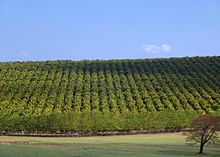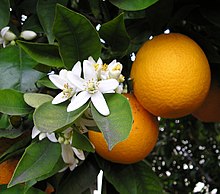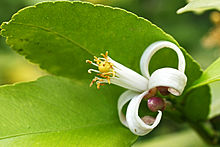Orange (fruit)
![]()
Orange trees is a redirect to this article. For the 1878 painting by the French painter Gustave Caillebotte, see The Orange Trees.
The orange (pronunciation: [oˈʁaŋʒə] or [oˈʁɑ̃ːʒə]), north of the Speyer line also called Apfelsine (from Low German appelsina, literally "apple from China/Sina"), is an evergreen tree, in particular its fruit is also called so. The valid botanical name of the orange is Citrus × sinensis L., thus it belongs to the genus of citrus plants (Citrus) in the rue family (Rutaceae). It originates from China or Southeast Asia, where it was created from a cross between the mandarin (Citrus reticulata) and the grapefruit (Citrus maxima).
The bitter orange, which originated from the same parent species, is distinguished from the sweet oranges because of their entirely different uses. While the bitter orange arrived in Italy in the 11th century at the latest, the sweet variety was not introduced to Europe until the 15th century, where it was initially cultivated almost exclusively in Portugal. The sweet orange is the most commonly cultivated citrus fruit in the world.
Description
Vegetative characteristics
Orange trees are small to medium-sized evergreen trees with growth heights of up to 10 metres. The round tree crown has regular branching. The young twigs are angular and covered with thin, flexible, rather blunt thorns up to 8 cm long.
The alternate and spirally arranged (unifoliate) stem leaves are divided into petiole and leaf blade. The petiole is obovate, only slightly broadened (winged), with a narrow base, 1 to 3 cm wide and 0.6 to 1.5 cm long. The leathery, thick, dark green leaf blade is clearly separated from the petiole, with a rounded leaf base, oval and pointed.
The cotyledons are milky white.
Generative characteristics
The flowers stand singly in the leaf axils or together in few-flowered, racemose inflorescences. The fragrant flowers are radially symmetrical and hermaphroditic or purely male with a double perianth. The four or five sepals are fused. The five free petals are white in colour. There are 20 to 25 stamens, the filaments of which are fused at their bases into several groups. The ovary is oval and clearly separated from the style. In Europe the orange flowers from February to June, in China from April to May.
Orange trees - like many other citrus fruits - develop fruit even without cross-pollination. In the fruit (Hesperidium), the sarcocarp consists of ten to thirteen segments filled with sap tubes of mostly orange, occasionally yellow to red color. Each segment is surrounded by a thin membrane (endocarp), the whole fruit by a bipartite shell. The inner layer of the skin is white (mesocarp, albedo), the outer layer is orange or green when ripe (exocarp, flavedo). Numerous oil glands are located in the ripe fruit skin and exude an aromatic fragrance. The skin and segments are fused together and the fruit is more difficult to peel or divide than other citrus fruits. The central axis of the fruit - unlike the bitter orange - is not hollow. Each fruit contains many seeds. The large, oval seeds have a rough seed coat and a white interior. Each seed contains one to usually many embryos of varying sizes. In China, the fruits ripen from September to December.
The basic chromosome number is n = 9, besides diploid forms also polyploid forms occur.

Plantation in Brazil

Freshly harvested oranges

Orange blossom and orange.

Orange blossom and bud

Habitus of the orange tree.
Color and quality of the fruit
In regions with tropical-warm nights and high humidity, the fruits remain green during ripening. The color orange is therefore not a ripeness characteristic. Since many consumers consider the green color to be an unripe characteristic, the green fruits are usually degreened before sale by exposure to ethylene gas, which destroys the green chlorophyll in the skin. Any resulting loss of quality is accepted for the sake of better marketing.
The EU marketing standard for citrus fruit stipulates that the coloration of oranges must be typical of the variety. A maximum of one fifth of the peel may be light green in colour. However, oranges produced in areas with high air temperatures and high relative humidity during the development period may have more than one fifth of the peel coloured green. (In addition, all oranges must have a minimum juice content of 30% to 45%, depending on the variety). Degreening is permitted in the EU.
Questions and Answers
Q: What is the term orange referring to?
A: The term orange is referring to a number of citrus trees that produces fruit for people to eat.
Q: Where did sweet oranges originate from?
A: Sweet oranges originated from South and East Asia but now grows in lots of parts of the world.
Q: How do you identify an orange tree?
A: An orange tree can be identified by its dark green shiny leaves and small white flowers with five petals.
Q: What does the outside layer of an orange contain?
A: The outside layer of an orange contains acid.
Q: Are there any seeds inside each segment of most types of oranges?
A: Yes, there are usually seeds called "pips" inside each segment of most types of oranges.
Q: Why are oranges important food sources in many parts of the world?
A: Oranges are important food sources in many parts of the world because they are a commonly available source of vitamin C, they last longer than many other fruits when stored, and they can be easily transported without being damaged due to their tough skin acting as a container.
Q: What other purposes does the orange have besides being eaten as a fruit?
A: Besides being eaten as a fruit, oranges also have wide variety uses including cosmetic and medicinal purposes such as doctors prescribing them for people who suffer from diabetes.
Search within the encyclopedia